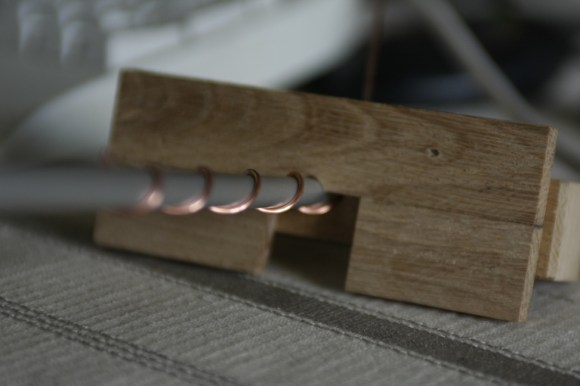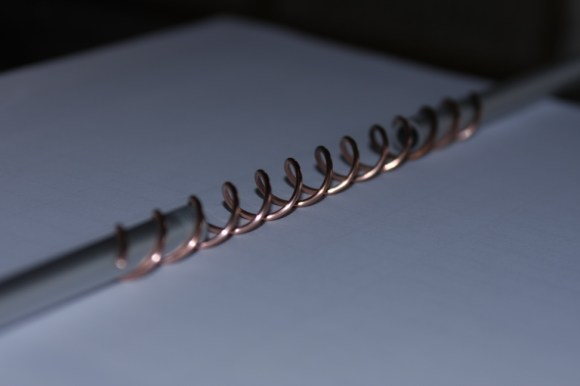
Sometimes while working on a project there comes a point where a specialized tool is needed. That necessary tool may or may not even exist. While [Fabien] was working on his DNA Lamp project he needed to bend a copper wire into a helical shape. Every one of us has wrapped a wire around a pencil and made a little springy thing at some point. While the diameter may have been constant, the turn spacing certainly was not. [Fabien] came up with a simple gizmo to solve that problem.
The tool utilizes an 8mm rod that will ensure the ID of the helix is indeed 8mm. We’ve already discussed that was the easy part. To make certain the turn spacing is not only consistent but also of the correct amount, a wooden frame is used. The frame has holes in it to allow the 8mm rod to pass through. Adjacent to those rod holes are much smaller holes just a bit larger than the copper wire that will become the helix. These holes are drilled at an angle to produce the correct turn spacing. [Fabien] figured out the correct angle by taking the desired turn spacing distance, helix diameter and wire diameter and plopping it in this formula:
asin((helixDiameter+wireDiameter)/(turnSpacing+wireDiameter))
asin(8+1.5/24+1.5) = 21.87°….. 22° is close enough…
At this point the rod is inserted into the wooded frame and the wire is passed through the 22° hole. The wire is then held to the rod and when the wooded frame is twisted, a perfectly spaced helix is left in the wake. The measured variation of the 24mm spaced helix was only 0.2mm. [Fabien] is not done with his lamp yet but he expects it to be completed in a couple weeks. We are looking forward to it.
















That’s clever. Could potentially see that method being used for home turning nichrome wire to make a hot, even, heating element.
You would probably have to machine that and use grease, as nichrome is much harder than copper.
I tested this tool with 0.5mm inox wire and it works rather well but you need more tension, and the (small) wire makes a groove in the wood. Maybe adding an aluminium or brass plate between the two main wood pieces is a better idea. Or you could insert a brass tube inside the fedding hole.
This might be a good way to make helical antennas also ++++++
for very high frequencies? yes. for 160 meter HF helicals I actually use a different trick that has some waste. you run 3 identical 20awg copper wires next to each other and turn the pole on a drill while you move the jig holding the spools carefully. then remove two of the three wires from the antenna. you now have the exact spacing needed perfectly all the way up the 12 foot long pole if you remove the spacer wires carefully you can re wind it back on spools for a few more uses before they get work hardened and are useless.
I tryed this approach earlier also, but I hade to run 5 or 6 wires for my design and I just could not get them a clean result this way. Though with 2 wires it worked well :)
Shouldn’t use the same wire many times. Always use one of the previous spacer wires as the new antenna wire, and you’ll never waste any wire because the spacers get replaced continuously.
Mildly off topic, but I’m in the need to turn a vinyl tube into a spiral such like this, any thoughts on how to set it and make it retain the shape?
Wrap it around a metal form and use a steam from a boiling tea kettle that might do the trick.
why / what would you do with a vinyl tube?
Spiral cord was commonly used in the era before cell phones. It allowed efficient use of space, reduced tangling, and also tethered devices while maximizing their range.
Spiral cord reduced tangling? Huh! I remember phones before tangles. Six foot. Sit down, there is a chair of course.
Let’s talk guitar, electric of course. Again I remember when the coiled cords came out (sissy), then they’re norm, now most guitarists won’t use them as they can’t carry good shielding and be light and flexible. Hell, textile covered cords are even back.
Stretch ratio was always poor as well, not even 2:1 except good old Ma Bell stuff.
If the hack with vinyl tubing is for springiness, PEX or some tough but springy plastic might be better with heat resetting.
If you pull on the coiled cord hard enough, the actual wires inside will shift out of position and the coil will buckle and never wind back up right again.
http://empegbbs.com/ubbthreads.php/ubb/download/Number/5832/filename/PhoneCord.jpg
OCD nightmare.
“How It’s Made” video on making the spiral cord: http://youtu.be/wTmzg6WMnf0
I didn’t watch the whole thing again, but I think when I watched it on TV there was some proprietary bit that wasn’t divulged. Perhaps the video may be of some help though.
Weaving two together would make cool wires for a Jacob’s Ladder setup.
If you ask me, this is missing one critical picture showing the setup of the drill press when the angled hole is drilled. I can set the angle on the drill press just fine – the table only tilts on one axis. However, the position of the part on the table is not described, therefore the angle of the hole can go in a wide variety of directions. All that’s written is that the hole in tangent to the rod…